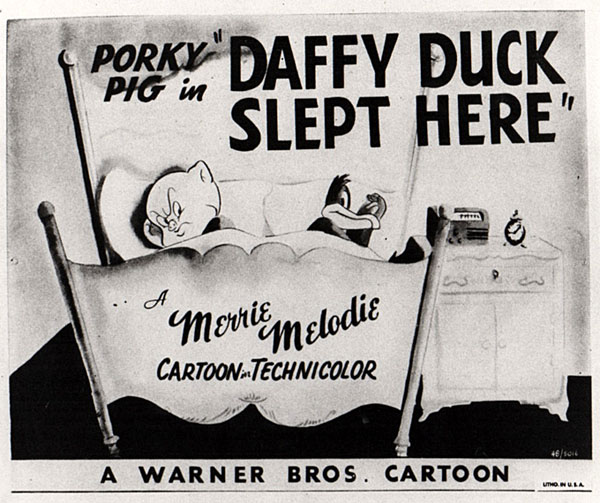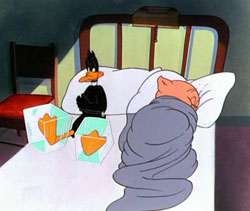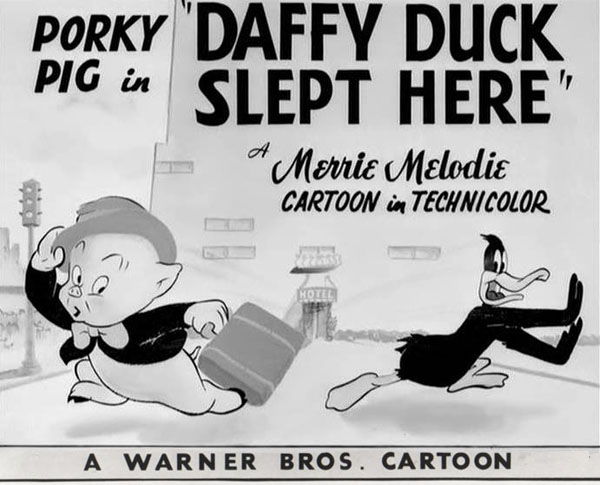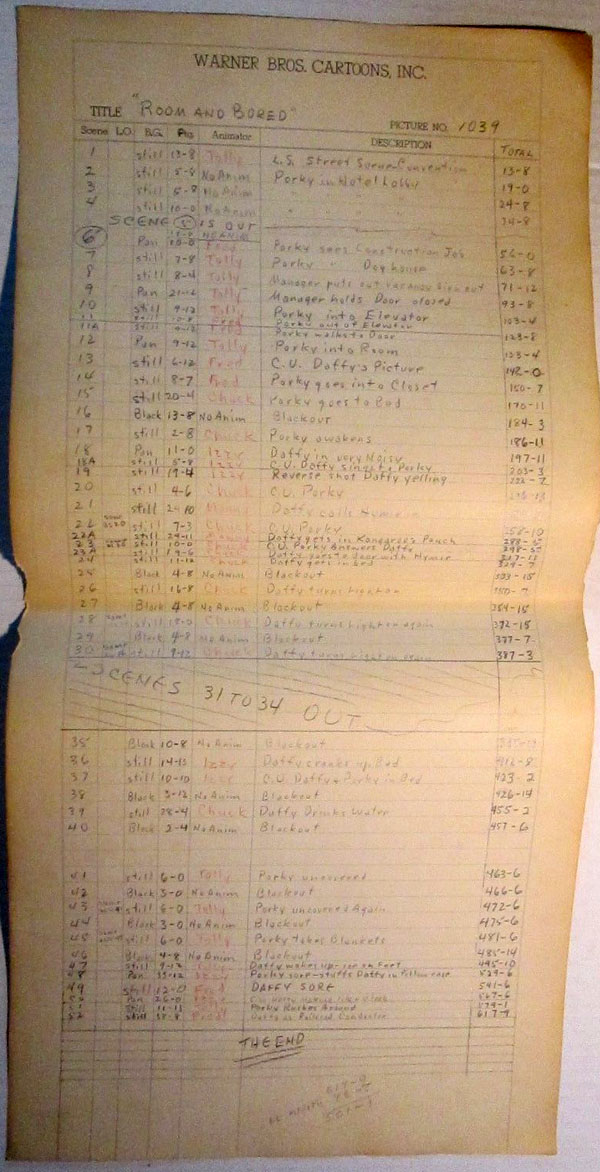
Thanks for casting your votes, readers! Hillbilly Hare (1950) ran a very close second, but Daffy Duck Slept Here (1948) is declared the winner this week…
Daffy Duck Slept Here is the second pairing between Porky Pig and Daffy Duck by Bob McKimson. The first was his first directorial effort, Daffy Doodles (1946). The working title on the production draft lists it as “Room and Bored,” but the final title of the cartoon is a takeoff on the Jack Benny-Ann Sheridan comedy George Washington Slept Here (1942), adapted from a play by Moss Hart and George S. Kaufman. While the live-action feature built around the situational humor of home renovation, this film involves businessman Porky sharing a hotel room with the “level-headed” Daffy, with no alternative available due to a citywide convention that has taken over.
 Mel Blanc recorded the dialogue track for this film on February 23rd, 1946. The story is credited to Warren Foster, whose roots in New York and crafty personality was key to the impetuous nature of McKimson’s cartoons during the 1940s. Foster did not care to share his story ideas with colleagues. Lloyd Turner, who became a writer for Art Davis’ unit, remembered Foster’s working methods as a writer: “Warren worked on a little riser, at an old desk, in a Life magazine. He’d open the Life magazine, put his sketches in there and draw, and if you came in, he’d close the magazine. He wouldn’t let you see what he was doing. You’d only see it when he pinned it up on the board.” Turner also recollected how Foster presented a storyboard during a jam session, with many of the artists present: “Warren was very good at telling a story, and he was a giggler; he would get a big kick out of his jokes…He’d kind of slip into his New York thing. He had more of a Brooklyn accent; he almost went into character when he told the story. But it wasn’t one of the characters, it was Warren’s New York side…He’d giggle, and he’d lead you up to a gag; he had a good sense of timing. When things didn’t work, he was able to ad lib something apropos for the dead spots.”
Mel Blanc recorded the dialogue track for this film on February 23rd, 1946. The story is credited to Warren Foster, whose roots in New York and crafty personality was key to the impetuous nature of McKimson’s cartoons during the 1940s. Foster did not care to share his story ideas with colleagues. Lloyd Turner, who became a writer for Art Davis’ unit, remembered Foster’s working methods as a writer: “Warren worked on a little riser, at an old desk, in a Life magazine. He’d open the Life magazine, put his sketches in there and draw, and if you came in, he’d close the magazine. He wouldn’t let you see what he was doing. You’d only see it when he pinned it up on the board.” Turner also recollected how Foster presented a storyboard during a jam session, with many of the artists present: “Warren was very good at telling a story, and he was a giggler; he would get a big kick out of his jokes…He’d kind of slip into his New York thing. He had more of a Brooklyn accent; he almost went into character when he told the story. But it wasn’t one of the characters, it was Warren’s New York side…He’d giggle, and he’d lead you up to a gag; he had a good sense of timing. When things didn’t work, he was able to ad lib something apropos for the dead spots.”
As the film opens, Porky’s attempts in securing a hotel room are shown in three different held poses which illustrate his increasing frustration in each rejection. Seen in a brief series of sight gags, the search for other rooms becomes so futile that people are willing to wait until a more spacious hotel (with 10,000 rooms!) is erected—not to mention the cheap flophouses and dog kennels that are also in full capacity. Porky obtains a room at last, but must share with another resident. Before Porky enters his room, he experiences a “jet-propelled” elevator ride to the 30th floor, which only takes mere seconds.
Though Daffy Duck Slept Here credits three animators under the opening titles, the production draft notes that Anatolle “Tolly” Kirsanoff and Fred Abranz were assigned to the first minute of footage. According to the in-house Warners Club News magazines, Kirsanoff and Abranz were promoted from assistants to full animators around the same time by late 1944. There’s still no circumstantial evidence why their work went uncredited on any Warners cartoon.
 After Porky settles into bed, hoping for quiet, an inebriated Daffy bursts the door open and sings loudly about his imaginary chum, a six-foot kangaroo named Hymie. The scene of Daffy outside of the room is not listed in the draft, but is certainly Manny Gould’s work, based on the timing/drawing of his other scenes in the film. Scene 17 of Porky awakened by Daffy (animated by Charles McKimson), has an effective layout accommodated by a double-exposure shadow effect, which immediately contrasts the two characters in that this roommate is the opposite of level-headed. Izzy Ellis animates Daffy’s improper greeting as he sings a blending of different tunes about Hymie—a parody of the old hit song “I’m Just Wild about Harry” which then shifts to “For He’s a Jolly Good Fellow”—which ends in an energetic rally chant (“H-Y-M-I-E…”) Daffy’s invisible friend is obviously a nod to the then-Broadway hit Harvey, about a man with an imaginary six-foot rabbit, which opened in 1944 and continued its theatrical run up until 1949, which then became a notable film adaptation starring James Stewart, released in 1950.
After Porky settles into bed, hoping for quiet, an inebriated Daffy bursts the door open and sings loudly about his imaginary chum, a six-foot kangaroo named Hymie. The scene of Daffy outside of the room is not listed in the draft, but is certainly Manny Gould’s work, based on the timing/drawing of his other scenes in the film. Scene 17 of Porky awakened by Daffy (animated by Charles McKimson), has an effective layout accommodated by a double-exposure shadow effect, which immediately contrasts the two characters in that this roommate is the opposite of level-headed. Izzy Ellis animates Daffy’s improper greeting as he sings a blending of different tunes about Hymie—a parody of the old hit song “I’m Just Wild about Harry” which then shifts to “For He’s a Jolly Good Fellow”—which ends in an energetic rally chant (“H-Y-M-I-E…”) Daffy’s invisible friend is obviously a nod to the then-Broadway hit Harvey, about a man with an imaginary six-foot rabbit, which opened in 1944 and continued its theatrical run up until 1949, which then became a notable film adaptation starring James Stewart, released in 1950.
Manny Gould does not animate much footage, but is assigned to some prime acting in the film, with his use of broad gestures and extensive dry-brush—the latter not often associated with his work. Gould handles Daffy eagerly inciting his roommate to ask about Hymie, and responding in a faux-humble manner upon Porky’s inquiry. In another scene by Gould, after the skeptical Porky accuses Daffy of being “pixilated” (exploiting Daffy’s drunken behavior), he proceeds to unzip Hymie’s pouch and bounce around the room, only seen from the neck up. Charles McKimson continues the sequence as Daffy escorts Hymie out of the room, arranges to get together for drinks the following day, and crawls into bed with Porky.
Naturally, part of the cartoon’s second half consists of Daffy disturbing Porky’s sleep in various ways. In a routine perhaps inspired—if not lifted directly— from vaudeville, Daffy asks Porky the meaning of the terms “buenos noches” and “bonsoir” but is not given a clear answer (animated by Charles McKimson). Next, Daffy tries to adjust the bed’s height by hand-cranking it at the front, which causes it to rumble and sputter like an old jalopy (animated by Izzy Ellis).
 In the next scene, credited to Charles McKimson, Daffy suffers a hiccupping fit and takes a drink of water, but the remainder of the glass spills onto Porky’s side, reprised from a similar bodily function gag in Bob Clampett’s Porky’s Badtime Story (1937). After the two fight over their share of the blanket, with Daffy placing his “foot-sicles” onto his bedmate, Porky decides to rid himself of his pesky (and unsanitary) roommate inside of a pillow case and out of the window. Izzy Ellis’ animation in this scene showcases a resourceful method— Porky rants to Daffy, all while grabbing and stuffing him into the pillowcase, whereas a less efficient fashion would be to animate the dialogue, and have the character perform their action after.
In the next scene, credited to Charles McKimson, Daffy suffers a hiccupping fit and takes a drink of water, but the remainder of the glass spills onto Porky’s side, reprised from a similar bodily function gag in Bob Clampett’s Porky’s Badtime Story (1937). After the two fight over their share of the blanket, with Daffy placing his “foot-sicles” onto his bedmate, Porky decides to rid himself of his pesky (and unsanitary) roommate inside of a pillow case and out of the window. Izzy Ellis’ animation in this scene showcases a resourceful method— Porky rants to Daffy, all while grabbing and stuffing him into the pillowcase, whereas a less efficient fashion would be to animate the dialogue, and have the character perform their action after.
In scene 49, credited to Fred Abranz, Daffy is first shown wrapped in bandages and on crutches on the windowsill, but he sakes them off and vows to take vengeance. After pulling down an artificial sunrise shade, Izzy Ellis animates Daffy acting as Porky’s wake-up call (acting as rooster, alarm clock and bugler), and puts him through a hasty exercise regimen before sending the drowsy businessman, with his suit and hat over his pajamas, to pack his luggage (animated by Kirsanoff). Fred Abranz animates the final shot of the film, where Daffy dresses as a train conductor, to further the illusion, announcing destinations to “Anaheim, Azusa and Cu…ca-monga!”, an inside reference to Mel Blanc’s character on The Jack Benny Program.

The orchestral score for Daffy Duck Slept Here was recorded a year after the dialogue track, on March 1st, 1947. The ASCAP approved the cue sheet a few months later on June 3. The film was copyrighted on December 27th, 1947. As for the release of the film, some sources attribute its date to March 6th, 1948. However, some newspapers list dates prior to this, as early as February 8th, 1948—still nearly two years after production began. The reasoning for the delay from production to finished product stems from labor strikes and shortage of materials at Technicolor, which affected the release schedules of all the major studios after World War II. Since animated short cartoons occupied the least priority during this procedure, a considerable backlog built up. (A few Warners cartoons were processed in Cinecolor during the late 1940s as a cost-cutting measure to alleviate these delays.)
Enjoy the breakdown video, and bon sewer! Again, please excuse the image quality of the draft pages here. Unless someone has bought this recently, it would be nice to share scans at a higher resolution, if possible. A devoted reader, named “Ian”, has graciously shared scans of the draft he now owns for A-Lad-in His Lamp.

As some of you readers may know, I will be contributing to Cartoon Research on a bi-monthly basis from here on, since I have decided to dedicate more time to digital restoration for Thunderbean Animation. I am very pleased to announce that I have nearly finished Movie Mad (1931), sourced from MGM’s original 35mm fine-grain master positive, which looks gorgeous. There are some shrinkage issues (resulting in some ‘rocky’ gate weave) in the last minute of the film—which still needs manual clean up—but this will be easily fixed. I will certainly share more progression updates as I continue to post on this column. See you folks in October!

Before (left) and after digital clean-up (right).
(Thanks to Jerry Beck, Keith Scott and Andrew Gilmore for their help.)


 DEVON BAXTER is a film restoration artist, video editor, and animation researcher/writer currently residing in Pennsylvania. He also hosts a
DEVON BAXTER is a film restoration artist, video editor, and animation researcher/writer currently residing in Pennsylvania. He also hosts a 




















































































Thanks Devon!
Enjoy your Thunderbean gig.
Bonus notches.
If only Robert McKimson’s cartoons stayed at this energy level, he might’ve been as warmly regarded as Friz and Chuck.
Anyway, this cartoon contains one of my all-time favorite Daffy quotes:
“Good night, fat boy!”
I love how Daffy is still daffy and not sarcastic in this cartoon.
Daffy created the prototype for “Magic Fingers”?
“UNSANITARY????????????”
My sister Erin and I when we we’re younger played out the “buneos noches’ bit at her bedroom. That is still one of my favorite Daffy/Porky episodes
I’m so glad that all the terrific “body language” in this film is pointed out. My favorite Daffy scenes herein is his conversation with Hymie, jumping into his pouch to prove to Porky that he exists and then slapping him on the back as they walk toward the door. You can almost imagine Hymie by Daffy’s side in this expert pantomime and, yes, I love the scene when an angry Porky is stuffing Daffy inside a suitcase to toss him out the window, talking all the while he does so, and we even hear the suitcase crash to the ground as Porky explains to us that he “hated to do that, but I gotta get some s-s-s-sleep!” I’ll bet it goes down in history as one of the best Daffy Duck cartoons of all time simply because fans can remember the dialogue so well. “Bum sewer!!”
Hymie should have been through the whole cartoon…